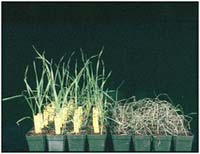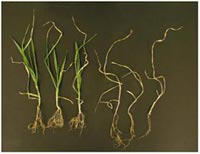September, 2004
CIMMYT took a historic step in March 2004 by planting a small trial of genetically engineered wheat in its screenhouse at headquarters in El Batan, Mexico. It was the first time that transgenic wheat has been planted in Mexico under field-like conditions, and encouraging results have spurred plans for a more extensive follow-up trial.
  DREB plants (left) next to non-DREB plants (right) in the trial. DREB plants (left) next to non-DREB plants (right) in the trial. |
Striving for Drought-Tolerant Wheat
Researchers used genetic engineering to insert a gene from Arabidopsis thaliana, a relative of wild mustard, into wheat. The gene, DREB1A, was provided by the Japan International Research Center for Agricultural Sciences, and has been shown to confer tolerance to drought, low temperature, and salinity in its natural host. The small trial completed this year was conducted in full accordance with Mexican and CIMMYT biosafety procedures, and represents a critical step toward developing drought-tolerant wheat varieties by allowing scientists to see how the DREB1A-expressing wheat responds under more natural conditions.
Drought is one of the most important agricultural production problems in the world. Combined with shortages of irrigation water, it threatens the ability of many developing countries to produce enough grain to feed themselves. Currently, the 20% of global farmland that produces 40% of the world’s food supply is irrigated.
“Drought is a complicated problem,” says CIMMYT cell biologist Alessandro Pellegrineschi, who led the trial. “When a plant is exposed to drought, there can be moisture stress, but there can also be heat or soil micro-element deficiencies or toxicities.” Because there are so many stresses, it is important to evaluate a potential solution under a variety of environments. Moreover, scientists are discovering that plants react to numerous stresses, especially to water deficiency and high levels of salt, in complex ways.
Encouraging and Consistent Results
Looking at the trial results, Pellegrineschi and colleagues were encouraged when they observed a more normal, non-stressed phenotype in the transgenic lines under drought conditions. Near the trial’s end, the non-DREB control wheat was dry, yellow, and shriveled, while the DREB wheat was still green and thriving. Pellegrineschi was surprised that a single gene could bring about such a visible response.
Pellegrineschi says the results of this trial, which is part of CIMMYT’s joint work with the Australian Cooperative Research Centre for Molecular Plant Breeding, are compatible with previous observations from small pots in the biosafety greenhouse. Many of the measured traits correlated with the improved performance of transgenic lines under water stress. However, the results need to be verified in a larger field trial with selected transgenic lines.
Taking Precautions
This is the first time that a food crop carrying the DREB1A gene has advanced to this level of testing. The Mexican government, which had announced a moratorium on planting transgenic maize under field conditions in 1998, approved the trial in December 2003.
CIMMYT followed strict biosafety procedures and worked closely with the government of Mexico in planning, conducting, and monitoring the trial. Access to the screenhouse was restricted. The researchers covered all plant flowers with bags and did not allow other wheat plants to grow within 10 meters of the trial, even though it is unlikely that self-pollinating wheat plants would cross with each other. After the trial, all plant materials except the harvested seed were destroyed.
What Next?
“This was the first trial transgenic wheat trial after the government removed the moratorium on growing transgenic varieties under field conditions, so we were very conservative in our request to the Mexican authorities for approval of the initial trial,” says Pellegrineschi. “Now that we have had some success, we will submit a request for a larger trial.”
Pending approval from the Mexican authorities, researchers are ready to begin a second trial, which will evaluate the best performing lines from the first trial more closely. In response to lessons learned from the first trial, the researchers are going to use a larger plot, have more replications, and restrict walking and the resultant soil compaction in the plots.
Five years ago, many people thought it was unrealistic that a single gene could improve a complex trait such as drought tolerance. With the right approaches, including the investment in proper field trials, Pellegrineschi believes that it will be possible to produce lines containing effective transgenes within five years.
Why Genetic Engineering?
With genetic engineering, useful genes for traits of interest can be transferred across species. DNA can be directly inserted into individual plant cells. The genetically altered tissue can be regenerated into complete plants and later transferred through conventional breeding into entire lines and varieties. This approach may also applied to rapidly and efficiently transfer traits within species for either research or development purposes. In both instances, CIMMYT remains committed to generating end-products that carry only the gene(s) of interest–that is, the undesired genes (marker genes) have been removed through conventional breeding.
Genetic engineering could increase the productivity and profitability of farming through reduced input use (lowering costs), added pest or disease resistance, and crops with better nutritional content or storage characteristics. Also, genetic engineering may solve problems that conventional breeding methods cannot. Nutritionally fortified crop varieties could be especially valuable in developing countries where millions of people suffer from dietary deficiencies.
Genetic engineering could become an important tool for introducing beneficial traits into maize and wheat. Efforts such as the DREB wheat field trail will allow our scientists to use a range of genes for the benefit of farmers and to pass on the products of cutting-edge technology to research partners in developing countries.
For more information: Alessandro Pellegrineschi or David Hoisington

